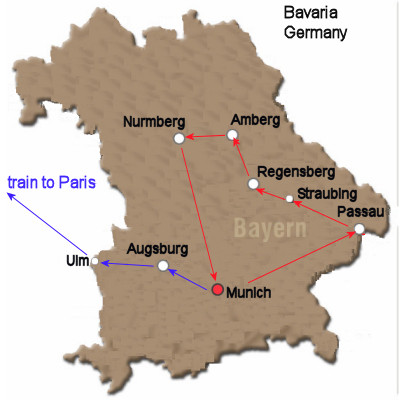
|
I am returning to Bavaria to see my German relatives and then taking the express train
to Paris to see the things I didn't have time for during my last visit:
Bavaria
Paris
My European travels are made possible in large part by the kindness of my German relatives,
who board, entertain, and help transport me about. My German cousin Frieda
has organized some
travel within Bavaria, the route of which can be seen on the map (left).
My grandfather grew up on a farm near Straubing. Some of my relations still
live there. Frieda's grandfather and my grandfather were brothers. My grandfather also had
a sister, and Frieda has also arranged for me to meet and stay with members of that family.
|
|

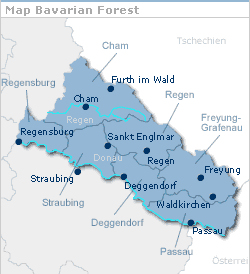
Here are the regions of Bavaria. Munich, located in Upper Bavaria, is the Bavaria capital.
Passau and Straubing are in Lower Bavaria.
Amberg and Regensburg are in the Upper Palatinate, while
Nuremberg is in Central Franconia.
The Bavarian Forest (German: Bayerischer Wald) upland area rises to the north of the Danube
between Regensburg and Passau and follows the wide curve of the river from north-west
to south-east.
|
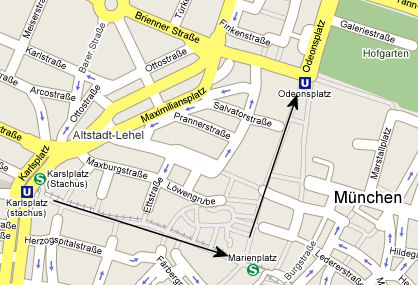
Thursday September 20, 2007.
Munich has excellent public transportation. I am spending the first few days
in the city and will spend several more after my loop around Bavaria. This day I took the
train from Pasing to the Karlstor stop. To me, everything's an adventure
when traveling in a foreign
country.
|
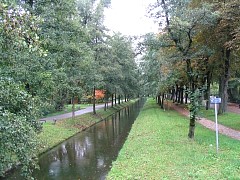
Walking from the Passing train station, this canal which runs to Nymphemburg Castle
is always the key to finding my cousin's house. It's early fall, the leaves are just beginning
to turn color, and there are many chestnuts on the ground. The water in this canal
runs very fast: trout-stream fast. I think I actually saw trout fry in the water.
|

I understand no German, so I couldn't figure out which train pass to buy.
A young family came by, I watched what button they pushed, then I put my euros in and
pushed the same button. I was rewarded with a 10 trip pass, a streifenkarte. No one
checks to see if you have bought a pass. There are places to stamp the time on
your pass as you use it up. If you are ever caught without a stamp within 2 hours
of the time you are examined, you are in big trouble. It's practically the honor system.
I have to admit more than once I forgot to stamp my card.
The center of Munich has many streets where no cars are allowed. I am going from
Karlsplatz to the Marienplatz then up Theatinerstrasse street to the Odeonsplatz.
I have arrived during the last warm sunny weather of the fall. Consequently,
it was a good time to sit in one of the small street-side cafes and people watch.
|
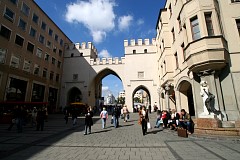
Of Munich's original five city gates, only three remain: the Karlstor,
Isartor and Sendlinger Tor.
This Munich inner city gate is Karlstor (Karl's gate).
It was part of a large 14th century city wall which replaced a smaller 12th century city
wall.
The city wall was destroyed around the year 1800, with the Karlstor becoming the center of a
new square named Karlsplatz. Two buildings were built next to the Karlstor,
forming a symmetrical half circle, symbolizing the opening of the city towards the outside.
|
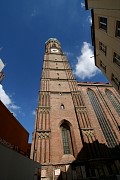
The Frauenkirche or Church of Our Lady is a Munich landmark. When I was married
we visited it on a
previous trip
|
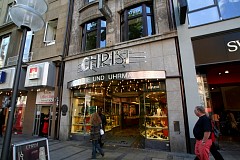
This storefront caught my eye. I don't believe you could name your store "Christ"
in the United States - some element of society would object.
This seems to be a jewelry store. Growing up we had neighbors with this last name,
which is most likely the case here. Still, telling your friend's your jewelry comes
from Christ might impress them ...
|
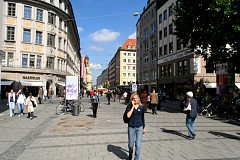
This picture illustrates several things: Munich has many attractive women, and I noticed
that a lot of younger people seem to smoke. European's seem to pride themselves on
healthy living, yet this obviously unhealthy habit is widespread. Fashion wise, boots
are in. I would say 20% of women 20-35 are wearing them.
|
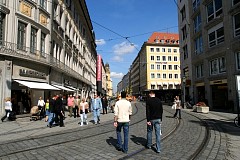
A little farther up the same street the scene shows a range of ages, from the very
young in a stroller to older gentleman from the last generation wearing a hat. Munich
also has a streetcar line. When you venture out of the city center, one has to be
aware of and ready to dodge 1) other pedestrians 2) bicycles 3) cars 4)
motorcycles and 5) streetcars.
|
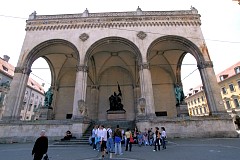
The most prominent structure on the Odeonsplatz is the Feldherrnhalle
or Field Marshal's hall, which sometimes makes the Odeonplatz look like an Italian square.
The Feldherrnhalle consists of three arches, with at the entrance two
Bayern lions. In November 1923 Hitler's Beer Hall Putsch was crushed
in the street just to the left of the Feldherrnhalle. It's a dark location, consequently
this photo is not the greatest quality.
|
|
The Feldherrnhalle was commissioned by King Ludwig I to honor the Bavarian army and
its victorious generals. It was designed by Friedrich von Gärtner and built from
1841 to 1844. The bronze statues of Count Tilly and Prince Wrede were sculpted by
Ludwig von Schwanthaler and cast from melted-down cannons. The "army monument"
in the center was added in 1892 by Prince Regent Luitpold. This monumental
bronze group created by Ferdinand von Miller commemorates the German-French
war in 1870/71. The marble lions flanking the steps are the work of Wilhelm
Rueman and date from 1905.
|
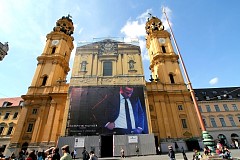
Just north and the west of the Feldherrnhalle is the copper-domed Theatinerkirche or
Theatiner church.
The church was built in Italian high-baroque style after the San Andrea del Valle
church in Rome and was designed by Agostino Barelli. He also led the construction of the
church from 1663 to 1669. His successor, Enrico Zuccalli finished the 71 meters/233 ft
high dome in 1690 and added two towers, which originally weren't planned.
The current facade in late rococo style was only finished in 1768 by François Cuvilliés.
The two small towers catch the eye with their curled shapes, and together with the
towers of the Frauenkirche and the Peterskirche, they define much of the Munich skyline.
Obviously, it's undergoing some renovation.
|
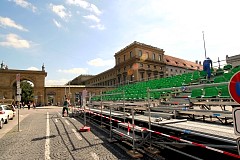
Oktoberfest is starting on Saturday - just a few days from now. Here in the Odeonsplatz
workers are setting up bleachers where people will view the opening parade. In the
background is the Residenz Palace. From 1385 to 1918 it served as the home of
Bavaria’s monarchs: now it's a museum. Unfortunately, I have not had the time to
check it out.
|
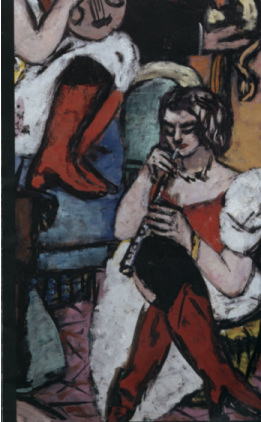
I visited the
Pinakothek Der Moderne (in English, The Modern Art Museum).
Together with the Alte Pinakothek and the Neue Pinakothek is part of
Munich's "Kunstareal" (the "art district").
Pinakothek der Moderne was inaugurated in September 2002 after seven years of construction.
It houses various art movements of the 20th century in the collection,
including Expressionism, Fauvism, Cubism, New Objectivity, Bauhaus, Surrealism, Abstract
Expressionism, Pop Art and Minimal Art.
The museum also displays masterpieces of Video, Photos and New Media.
No photography was allowed.
"Max Beckmann - Exile in Amsterdam" was the featured exhibition. Here are two
of his works. Beckmann left Germany in 1937 to get away from the Nazis and ended up
in Amsterdam. While where until 1947 he produced about 1/3 of his total body of
work.
|
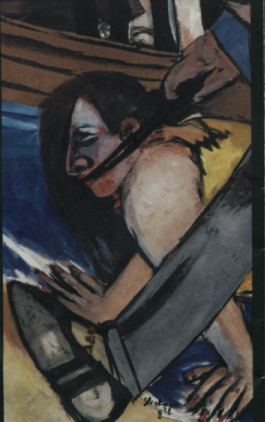
Needless to say, Beckmann's work is "controversial". As I stated before, I am
no art critic. I would characterize his work as a smattering of symbolic
swords mixed
with naked female butts and breasts all set in a background of cafes and
other social settings. It depicts decadence and anything goes.
I can see where in conservative Bavaria under Fascist control in the 1930's
would frown upon some of Beckmann's work.
I remember standing viewing a huge enlarged photo taken in an American
southern city showing one central house where the police are dealing with
a belligerent male while his wife runs out of the house toward her
husband in a panic while the immediate neighbors
look on with horror and fascination. The further you get away from the house
where the police are, the more "normal" life becomes as those people are
unaware of the drama a few blocks away. I guess you have to see it ...
|
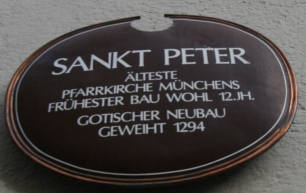 Back near the Marienplatz, which is the city center, I noticed people way up on the
steeple of a nearby church. Hey, I want to climb up there too, so I scouted around until
I found where to find the stairs. Affectionately known as Old Peter, St. Peter’s Church
is the oldest in the city of Munich.
Back near the Marienplatz, which is the city center, I noticed people way up on the
steeple of a nearby church. Hey, I want to climb up there too, so I scouted around until
I found where to find the stairs. Affectionately known as Old Peter, St. Peter’s Church
is the oldest in the city of Munich.
|
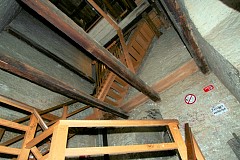
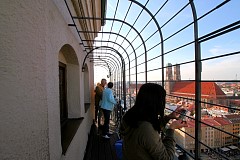
The climb is lengthy but all in all not difficult.
On a clear day when visibility is at its best and you may be able to see
all the way to the Alps.
|
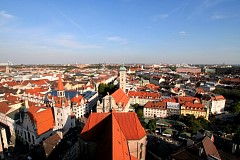
In this picture, the lower-right corner shows the Viktualienmarkt.
Established in 1807 by decree issued by Maximilian I, Viktualienmarkt (literally,
victuals market) was built to replace a much smaller market at Marienplatz that had once served
the needs of the burgeoning city of Munich. Victual is the Latin word for food.
|
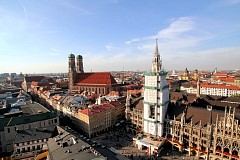
To the right (in Marienplatz ("St. Mary's Square")) is the New Town Hall (Neues Rathaus)
which was built between 1867 and 1909 by Georg Joseph Hauberrisser in Flemish Gothic style.
To the left, the twin-domed church is
the Frauenkirche or Church of Our Lady.
The foundation stone was laid by Duke Sigismund in 1468. Its distinctive domes, which were
built in 1525 would serve as a model for many of Bavaria's towers.
The church is huge but simple. Much of the original gothic interior has been destroyed
or removed partially by contra-reformists.
The square was originally known as Schrannen but it was renamed Marienplatz as a way to
ask Virgin Mary to protect the town from a cholera epidemic.
|
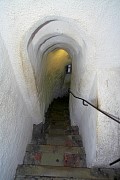
Back down the stairs to street level.
|